
Bridge Street Cemetery Northampton Architecture Historic Markers 
|


The Abolition Era: Old South Street
 |
 |
 |
 |
 |
67-69 Old South Street |
21 Conz Street |
30 Conz Street |
49 Lyman Road |
14 Fruit Street |
This historic marker recognizes the abolitionists Moses Breck, Seth Hunt and Henry S. Gere and the African-American presence in Old Street Street. |
Sponsored by the Daily Hampshire Gazette and MassHumanities |
Moses Breck: Liberty Party Founder and Underground Railroad Agent
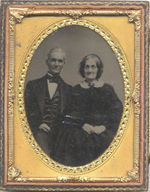 |
Moses & Eliza Breck |
Born on July 4, 1793, Moses Breck was among the original abolitionists in Northampton. Breck, J. P. Williston and Erastus Hopkins are most often mentioned as Northampton operatives of the Underground Railroad. He was a founding member of the Liberty Party and represented Northampton at the convention that nominated James G. Birney for president in 1840. Breck remarked, “It is the duty of every friend of his country to speak out plainly and freely against this crying sin of our land.” Unfortunately, his outspoken campaigning for abolition (as well as temperance) earned him enemies and his property was never safe from the backlash of reactionaries. His home and workshop on Elm Street were completely destroyed by arsonists in 1855. He lived out his days in his wife’s brother’s house at 67–69 Old South Street.
Seth Hunt: Connecticut River Railroad treasurer and abolitionist
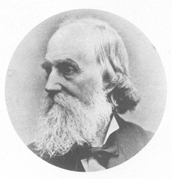 |
Seth Hunt |
Seth Hunt, the son of doctor David Hunt and a descendant from one of the earliest settlers of the town, was born in Northampton on July 28, 1814. Hunt was the long-time treasurer of the Connecticut River Railroad. As a Garrisonian abolitionist, Hunt differed from his Free Soil and Liberty Party neighbors in his belief that abolition was a struggle to be waged through “moral suasion,” not in the political arena. Hunt’s home at 21 Conz Street is reputed to have served as an Underground Railroad stop. Among his notable correspondents and house guests were Ralph Waldo Emerson, Henry Ward Beecher, Frederick Douglass, and William Lloyd Garrison.
In 1859 Hunt moved to a William Fenno Pratt designed house at 115 Bridge Street. After 1863, he regularly drove to Florence to attend meetings of the Free Congregational Society, the institutional descendant of the radical reformist Northampton Association of Education and Industry.
Henry S. Gere: Abolitionist Newspaper Editor
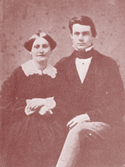 |
Henry S. Gere, born in Williamsburg in 1828, was a life-long newspaperman who gave voice to the area’s abolitionist movement. He apprenticed at the abolitionist Hampshire Herald established by J. P. Williston and Abijah Thayer then purchased the paper in 1847 at the age of nineteen. In 1849, Gere acquired the Northampton Courier then merged it with the Hampshire Gazette, which he owned at least in part, for the duration of his career. Gere guided Northampton’s abolitionist movement through the transition from the Liberty Party to the Free Soil Party, spearheading the election of Erastus Hopkins as a Free Soil representative in 1848. His book, Reminscences of Old Northampton: 1840 to 1850, still provides the best insight into the local “spirit of the age.” Pictured in the photograph at left is Henry S. Gere and his wife Martha in the 1850s.
Bathsheba Hull, The Freemans, Timothy Harley
& the African American Presence in Old South Street
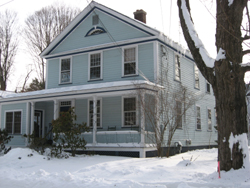 |
Haynes K. Starkweather House |
Bathsheba Hull lived on an island created by a channel from the Mill River, located in what is now the Round House parking lot. She was the mother of Northampton’s most famous native-born African American, Agrippa Hull (1759–1848) who served with distinction in the Revolutionary War. He later owned land in Stockbridge and worked in the Sedgewick household with Elizabeth Freeman whose lawsuit ended slavery in Massachusetts. In 1765, Bathsheba Hull battled the town for ownership of her land and lost. Her modest home was destroyed.
The 1850 census lists black residents Samuel and Lois Freeman, aged 80 and 73 years, living in the household of Luther Davis. The Freemans played an active role in abolitionist demonstrations organized by David Ruggles, a famous New York City abolitionist, who joined the Northampton Association of Education and Industry, a “utopian” community in modern day Florence, in late 1842.
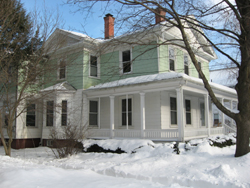 |
Timothy Harley House |
Ruggles assisted Basil Dorsey in his escape from slavery in Maryland. Dorsey arrived at the home of H. K. Starkweather on Old South Street (now at 49 Lyman Road) in 1838. Captain Samuel Parsons carried Dorsey to the home of Roger Hooker Leavitt in Charlemont, where he lived until 1844 at which time he returned to Northampton. Timothy Harley, a black barber who owned a substantial house on Fruit Street, listed the self-proclaimed fugitive slave George Wright as a member of his household in 1850. Wright and nine other former slaves called Northampton to meeting to resist the Fugitive Slave Law of that year.
Contents Historic Northampton.
